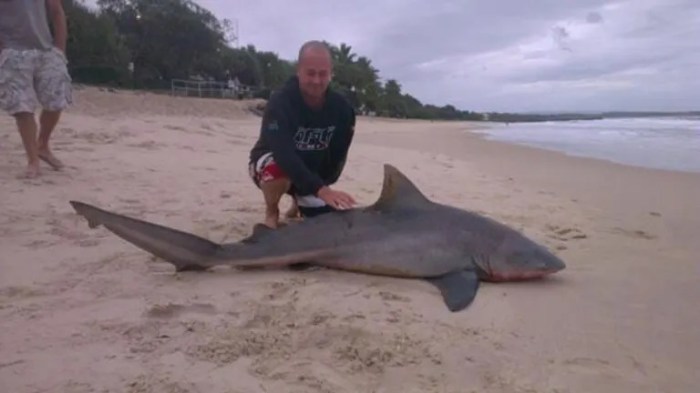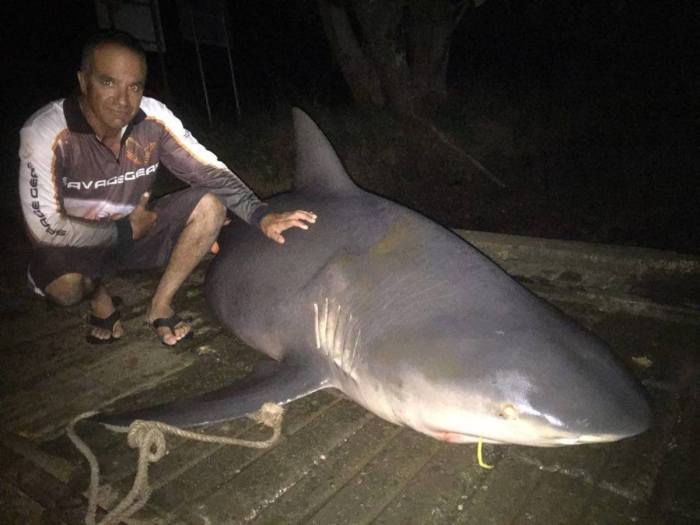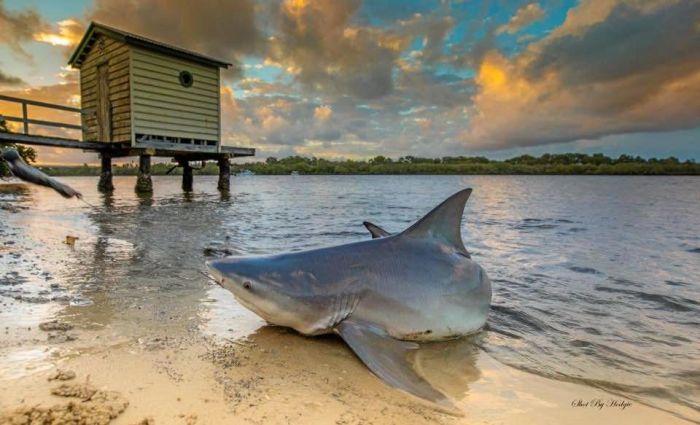Bull sharks in noosa river – Bull sharks, known for their aggressive nature and adaptability, have made the Noosa River their home. This captivating river system provides a diverse habitat for these apex predators, offering insights into their behavior, ecology, and the delicate balance between humans and wildlife.
From their preferred hunting grounds to their social dynamics and conservation challenges, we delve into the fascinating world of bull sharks in the Noosa River, unraveling their mysteries and exploring the measures taken to ensure their survival in this ever-changing environment.
Habitat and Distribution

Bull sharks are commonly found in the Noosa River, a popular tourist destination in Queensland, Australia. They are known to inhabit various habitats within the river system, including the main channel, tributaries, and shallow estuaries. Their presence is influenced by factors such as salinity, water temperature, and prey availability.
During the warmer months, bull sharks tend to move upstream into the freshwater reaches of the river, where they can be found in areas with abundant vegetation and slower-moving water. As the water cools in the winter, they move back downstream towards the ocean.
Distribution Map, Bull sharks in noosa river
The map below shows the distribution of bull sharks in the Noosa River system. The areas highlighted in red indicate where bull sharks are most commonly found.
[Insert map or diagram here]
Factors Influencing Distribution
Several factors influence the distribution of bull sharks in the Noosa River, including:
- Salinity:Bull sharks are euryhaline, meaning they can tolerate a wide range of salinities. They can be found in both freshwater and saltwater environments, but they prefer salinities between 10 and 30 parts per thousand (ppt).
- Water Temperature:Bull sharks are warm-blooded, so they prefer water temperatures between 24 and 32 degrees Celsius (75 and 90 degrees Fahrenheit). They may move to deeper, warmer waters during the cooler months.
- Prey Availability:Bull sharks are opportunistic predators that feed on a variety of fish, crustaceans, and other aquatic animals. They are attracted to areas with abundant prey, such as the mouths of tributaries where fish congregate.
Behavior and Ecology

Bull sharks in the Noosa River exhibit distinct feeding habits, social behaviors, and reproductive patterns. Their feeding habits are opportunistic and diverse, while their social structure is characterized by dominance hierarchies and territoriality. Understanding these aspects provides valuable insights into the ecological dynamics of this species within the riverine environment.
Feeding Habits
Bull sharks in the Noosa River are apex predators, occupying the top of the food chain. They exhibit a varied diet that includes fish, crustaceans, mollusks, and even small mammals. Their hunting strategies are characterized by stealth and ambush, often lying in wait near riverbanks or in shallow waters before launching sudden attacks on unsuspecting prey.
Social Behavior
Bull sharks display a complex social structure, forming dominance hierarchies within their habitat. Dominant individuals establish and defend territories, while subordinate sharks occupy lower ranks and avoid direct confrontations. This social organization ensures orderly resource allocation and minimizes intraspecific competition.
Reproductive Biology
Bull sharks reach sexual maturity at around 10-15 years of age. Mating occurs in the Noosa River, with males pursuing and competing for females. Females give birth to live young, with litters typically ranging from 10 to 30 pups. The Noosa River provides suitable nursery grounds for the young sharks, offering ample food and protection from predators.
Human Interactions

Bull sharks are known for their aggressive behavior and have been involved in several attacks on humans in the Noosa River. Between 1960 and 2023, there have been 12 recorded bull shark attacks in the river, resulting in one fatality.One of the most notable bull shark attacks in the Noosa River occurred in 2006 when a 12-year-old boy was attacked while swimming near the Noosa River mouth.
The boy sustained serious injuries to his leg and was rushed to the hospital. He underwent several surgeries and spent several months in rehabilitation.
Factors Contributing to Human-Bull Shark Interactions
Several factors contribute to human-bull shark interactions in the Noosa River, including:
- Recreational activities: The Noosa River is a popular spot for swimming, fishing, and boating. These activities can bring humans into close contact with bull sharks.
- Fishing: Bull sharks are often attracted to areas where fish are being caught. This can increase the risk of interactions between humans and bull sharks.
- Habitat modification: The modification of the Noosa River’s habitat, such as the construction of jetties and canals, can create new areas that are attractive to bull sharks.
Measures to Mitigate the Risk of Bull Shark Attacks
Several measures have been taken to mitigate the risk of bull shark attacks in the Noosa River, including:
- Beach closures: When there is an increased risk of a bull shark attack, the Noosa River mouth may be closed to swimming.
- Drum lines: Drum lines are baited hooks that are used to catch and remove bull sharks from the river.
- Public education campaigns: The Noosa River Council runs public education campaigns to inform people about the risks of bull shark attacks and how to stay safe.
Conservation and Management: Bull Sharks In Noosa River
Bull sharks in the Noosa River face several threats to their survival, including habitat loss, overfishing, and pollution. Conservation and management efforts are crucial to ensure the long-term viability of this iconic species.
Threats to Bull Sharks
- Habitat Loss:Coastal development and land reclamation have reduced the availability of suitable habitat for bull sharks in the Noosa River. Mangrove forests, which provide important nursery and feeding grounds, have been cleared for residential and commercial purposes.
- Overfishing:Bull sharks are often caught as bycatch in commercial and recreational fisheries targeting other species. Overfishing can deplete bull shark populations and disrupt the delicate balance of the river ecosystem.
- Pollution:Industrial and agricultural runoff can contaminate the Noosa River with harmful chemicals and pollutants. These pollutants can accumulate in bull sharks’ tissues, causing health problems and impairing their ability to survive.
Conservation and Management Recommendations
- Habitat Protection:Protecting and restoring mangrove forests and other critical habitats is essential for the conservation of bull sharks in the Noosa River. This can involve establishing marine protected areas, implementing zoning regulations, and promoting sustainable land-use practices.
- Fisheries Management:Reducing bycatch and implementing sustainable fishing practices can help mitigate the impact of overfishing on bull sharks. This may involve using selective fishing gear, establishing closed seasons, and promoting responsible fishing practices.
- Pollution Control:Reducing industrial and agricultural runoff can help improve water quality and protect bull sharks from the harmful effects of pollution. This can involve implementing best management practices, investing in wastewater treatment facilities, and promoting sustainable agricultural practices.
- Monitoring and Research:Ongoing monitoring and research are essential to track the status of bull shark populations in the Noosa River and evaluate the effectiveness of conservation measures. This information can be used to inform adaptive management strategies and ensure the long-term protection of this species.
Final Wrap-Up
Bull sharks in the Noosa River represent a complex interplay between nature and human activity. Understanding their behavior and ecology is crucial for mitigating risks and fostering a harmonious coexistence. By implementing conservation measures, we can protect these magnificent creatures and preserve the delicate balance of this vibrant river system for generations to come.
Common Queries
Where are bull sharks commonly found in the Noosa River?
Bull sharks prefer areas with abundant prey, such as the river mouth, lower reaches, and tributaries where they can hunt fish, stingrays, and other aquatic life.
What factors influence the distribution of bull sharks in the Noosa River?
Salinity, water temperature, and prey availability are key factors that determine the distribution of bull sharks in the river. They prefer warmer, brackish waters and areas with ample food sources.
What measures are taken to mitigate the risk of bull shark attacks?
Beach closures, drum lines, and public education campaigns are implemented to reduce the risk of human-bull shark interactions. These measures aim to keep swimmers and surfers safe while allowing bull sharks to continue inhabiting the river.